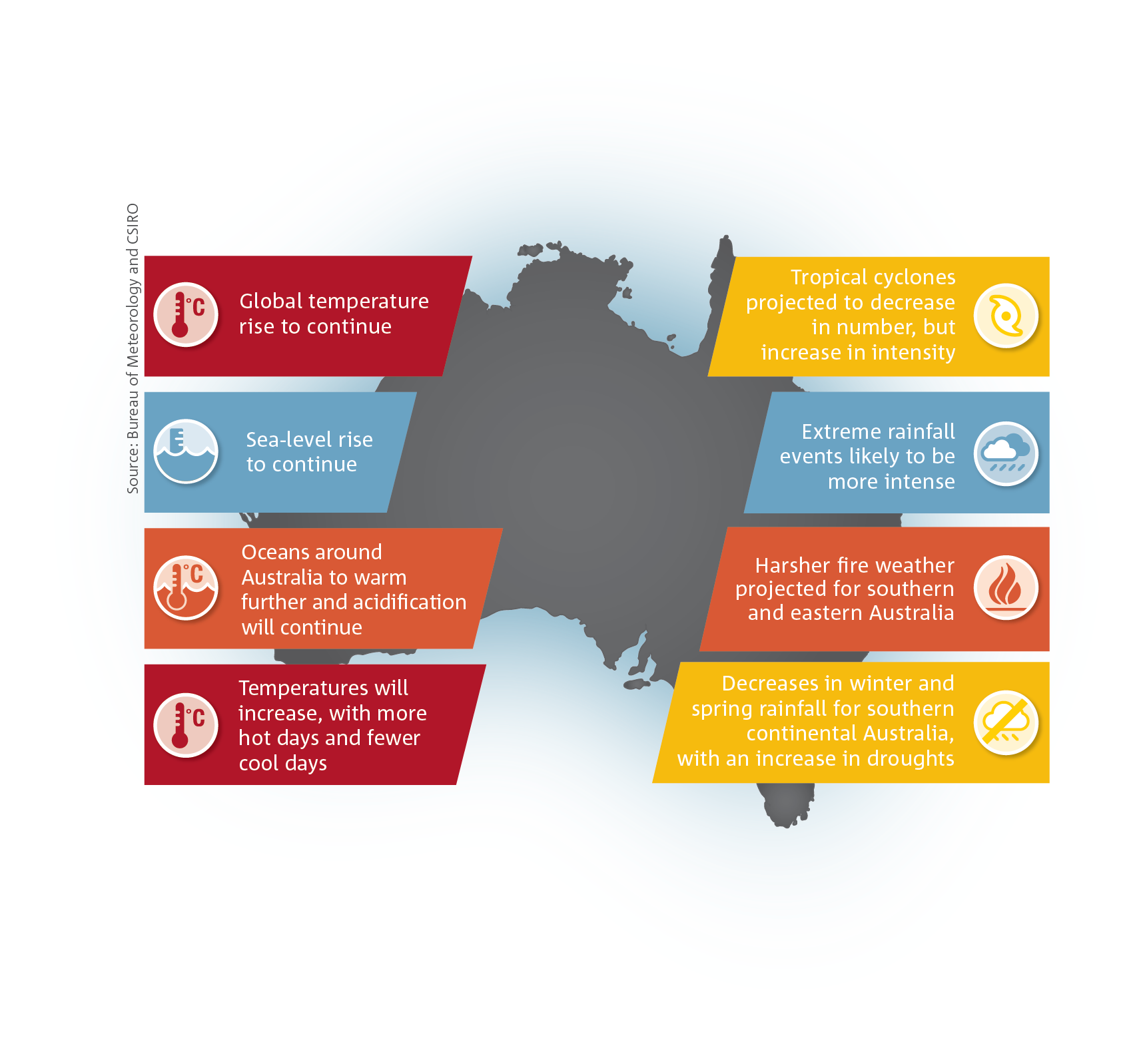Observed regional trends in rainfall and temperature can seem small when compared to daily, monthly and seasonal climate variability. However, such changes in the average climate, experienced over multiple decades, can have a large influence on ecosystems, agriculture and the built environment. In particular, the changing nature of rainfall and temperature extremes can have a noticeable impact.
As Australia’s climate evolves, a number of long-term changes, such as an increase in mean temperatures, are almost certain. The degree of change in temperature over the next few decades is relatively clear, while the extent to which the climate will change later in the century depends on the level of emissions now and into the future.
The Bureau of Meteorology and CSIRO, with other research institutions around Australia, have recently completed Climate Change in Australia, which describes likely changes to Australia’s climate over the coming century. The report and accompanying interactive materials are available at www.climatechangeinaustralia.gov.au.

Why are Australia and the globe warming?
Energy comes from the Sun. In order to maintain stable temperatures at the Earth’s surface, in the long run this incoming energy must be balanced by an equal amount of heat radiated back to space. Greenhouse gases in the atmosphere, such as carbon dioxide, act to increase the temperature of the Earth’s surface, ocean and the atmosphere, by making it harder for the Earth to radiate this heat. This is called the greenhouse effect.
Without any greenhouse gases, the Earth’s surface would be much colder, with an average temperature of about -18 °C. For centuries prior to industrialisation the incoming sunlight and outgoing heat were balanced and global average temperatures were relatively steady, at a little under 15 °C. Now, mostly because of the burning of fossil fuels and changes in land use, the concentrations of greenhouse gases in the atmosphere are rising and causing surface temperatures to increase.
There is now an energy imbalance at the Earth’s surface of 0.65–0.80 Wm-2 (averaged globally). The atmosphere and oceans will continue to warm until enough extra heat can escape to space to allow the Earth to return to balance. Because carbon dioxide increases persist in the atmosphere for hundreds of years, further warming and sea-level rise is locked in.
Observed regional trends in rainfall and temperature can seem small when compared to daily, monthly and seasonal climate variability. However, such changes in the average climate, experienced over multiple decades, can have a large influence on ecosystems, agriculture and the built environment. In particular, the changing nature of rainfall and temperature extremes can have a noticeable impact.
As Australia’s climate evolves, a number of long-term changes, such as an increase in mean temperatures, are almost certain. The degree of change in temperature over the next few decades is relatively clear, while the extent to which the climate will change later in the century depends on the level of emissions now and into the future.
The Bureau of Meteorology and CSIRO, with other research institutions around Australia, have recently completed Climate Change in Australia, which describes likely changes to Australia’s climate over the coming century. The report and accompanying interactive materials are available at www.climatechangeinaustralia.gov.au.
Why are Australia and the globe warming?
Energy comes from the Sun. In order to maintain stable temperatures at the Earth’s surface, in the long run this incoming energy must be balanced by an equal amount of heat radiated back to space. Greenhouse gases in the atmosphere, such as carbon dioxide, act to increase the temperature of the Earth’s surface, ocean and the atmosphere, by making it harder for the Earth to radiate this heat. This is called the greenhouse effect.
Without any greenhouse gases, the Earth’s surface would be much colder, with an average temperature of about -18 °C. For centuries prior to industrialisation the incoming sunlight and outgoing heat were balanced and global average temperatures were relatively steady, at a little under 15 °C. Now, mostly because of the burning of fossil fuels and changes in land use, the concentrations of greenhouse gases in the atmosphere are rising and causing surface temperatures to increase.
There is now an energy imbalance at the Earth’s surface of 0.65–0.80 Wm-2 (averaged globally). The atmosphere and oceans will continue to warm until enough extra heat can escape to space to allow the Earth to return to balance. Because carbon dioxide increases persist in the atmosphere for hundreds of years, further warming and sea-level rise is locked in.
